Triana district Seville what to see – 13 highlights to see and do
Top things to see and do in Triana Seville
In this article you will find essential information about the best things to see in the Triana district of Seville :
- A few words on the history of the Triana district
- Where is the Triana district?
- Visiting the Triana district and its essentials
- What to see and do in Triana
- Tapas and flamenco
- Things to do in Seville
- Some useful links for your holidays
- What to see in Seville after Triana
- Continuing your trip to Andalucia
A few words about Seville’s Triana neighbourhood
This site, the Triana district, has been inhabited for at least 2000 years. It has been well known since Roman times. It was a period that left its mark on the history of Seville.
During this period, two sisters, Justa y Rufina (Justa and Rufina), who were potters in the 3rd century on the site where Triana now stands, became saints and are venerated today in Seville. They are also considered to be the protectors of the Giralda and the Cathedral.

The floating bridge over the Guadalquivir
The Triana district really came into its own in the 12th century, in 1171, when the Almohad Berber caliph Abu Yaqub Yusuf decided to build a floating bridge, which was then known as the Puente de Barcas for a long time…. This was the only bridge to link Triana to the centre of Seville for almost 700 years!

The current Puente Isabel II was only built in 1847, on the site of this old floating bridge.
Triana and its people
Triana is the birthplace of many navigators, including Christopher Columbus. It is also known for its bullfighters. Many of the local personalities can be seen on the city’s walls.

The district has also been the birthplace of many famous flamenco singers, dancers and musicians.

Triana’s imprint is very strong in the hearts of its inhabitants. In fact, it’s said that the locals are Trianeros before they are Sevillanos. And don’t they themselves say that when they cross a bridge, it’s to go to Seville!
Where is the Triana district?
Seville’s Triana district is located opposite the Casco Antiguo, just across from the historic centre. To get to Triana, you can take three bridges across the Guadalquivir. From the centre, take the Pont Isabel II.
On the map, the district is outlined in red:
What to see and do in Triana of Seville?
- Calle Betis
- Triana Market
- Isabel II Bridge or Triana Bridge
- Chapel of the Carmelite Convent of Seville
- Little Museum of the Inquisition
- Patios and corrals of Triana
- Plaza del Altozano
- The ceramics museum
- Casa Cuesta bar and restaurant
- The church of Santa Ana
- Calle San Jacinto in Triana
- The facades of the streets of Triana
- Tapas and flamenco in Triana
- Casa de la Memoria
- Tablao Pura Esencia
- Triana Flamenco Theatre
- Bar Juan Carlos and its 100 cheeses
Betis Street a little treasure to see in Seville’s Triana neighbourhood
This is the best-known street in the Triana district. Its colourful houses are often photographed from the other side of the Guadalquivir, in the Arenal district.

This street, which runs alongside the River Guadalquivir, is closely linked to the river’s history. Today this river is called the Guadalquivir, a name taken directly from the name of the Al-andalus period: al-wādi al-kabīr.
In Roman times, however, the river was known as Betis, which also gave its name to the Betic region – Hispania Baetica – which is more or less what Andalucia is today.

Calle Betis is a picturesque street known for its river views, bars and restaurants. It’s a great place to relax in a restaurant in the evening, and enjoy the views, particularly of the Torre del Oro :
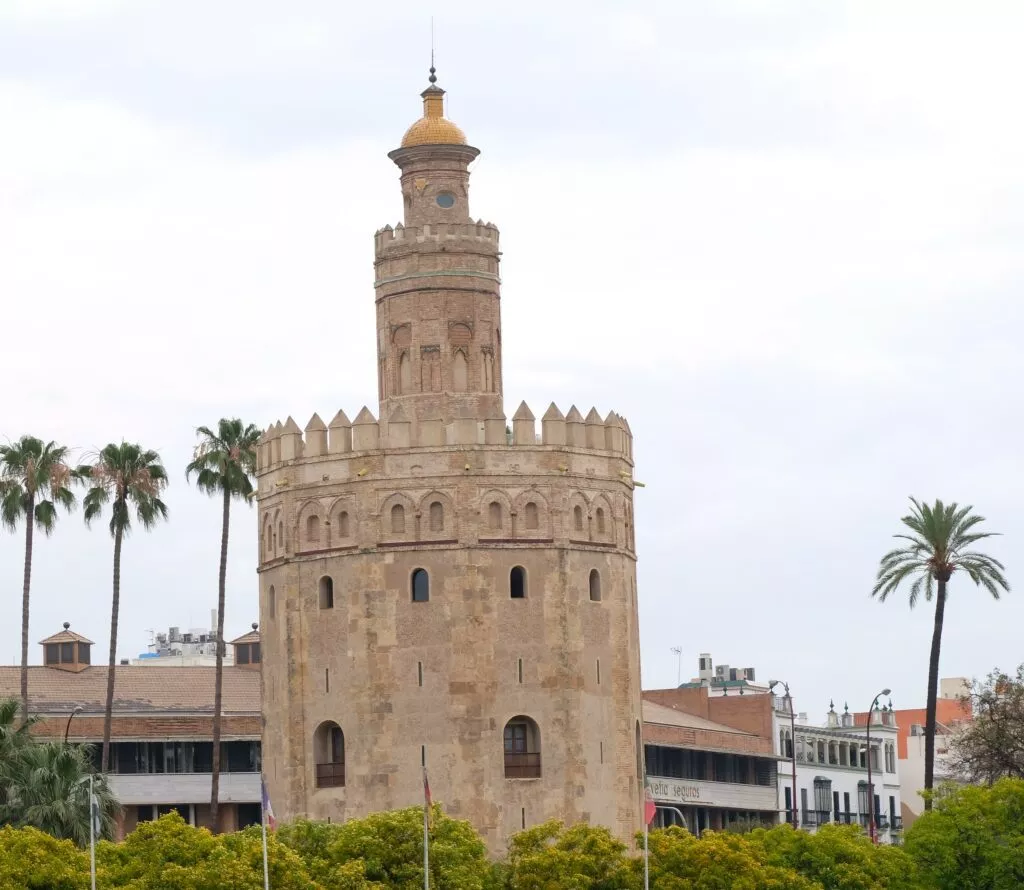
The market a must-see in Triana of Seville

Triana’s covered market is a delight to browse, with all its colourful stalls.
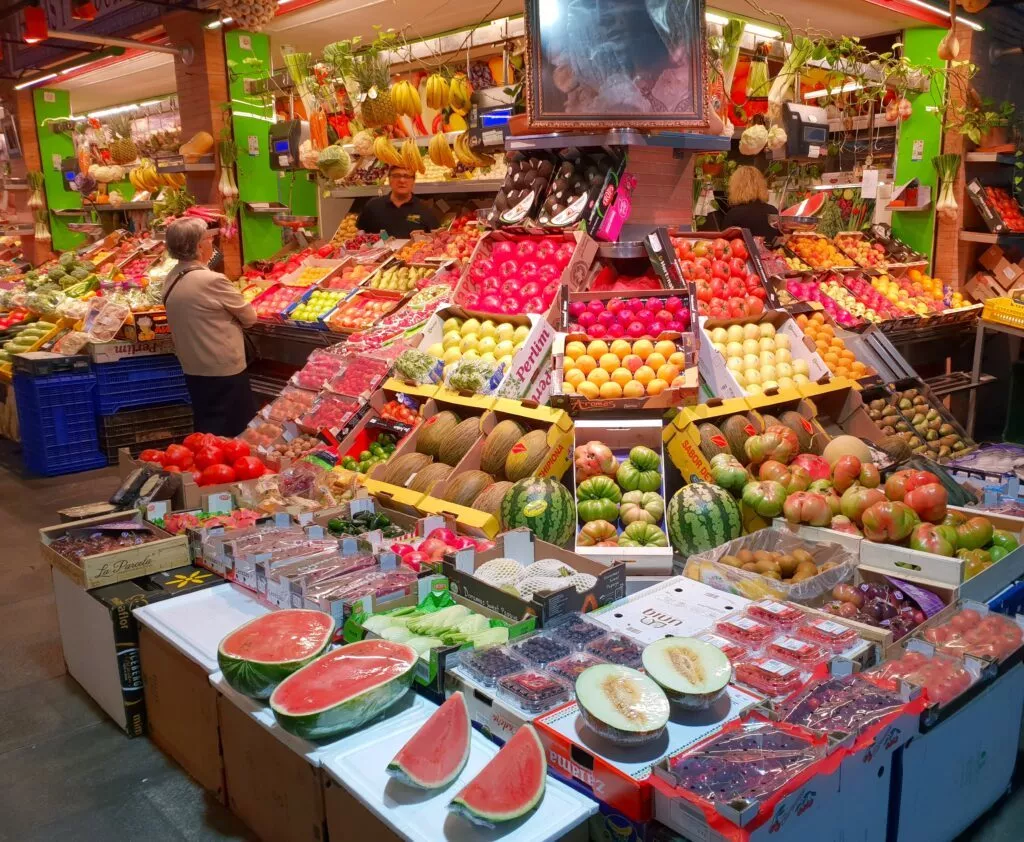
What’s more, this lively market is an excellent place to discover Andalusian cuisine, with numerous stalls selling fruit, vegetables, meat and cold meats.

Last but not least, don’t hesitate to sample some of the best local produce:

The Isabel II Bridge a historical treasure to be seen in Triana neighbourhood

Seville’s emblematic arched bridge links the Triana district to the historic centre, and to the Arenal and Santa Cruz districts.
Chapel of the Carmel of Seville
This chapel stands at the foot of the Triana bridge.

It is dedicated to the glory of the Virgin of Carmel, the patron saint of Seville’s sailors.

Just behind this chapel, along the river, you’ll find San Jorge Castle. From 1481 onwards, this castle housed the court of the Inquisition and its prison. It is now a curious little museum about the Inquisition!
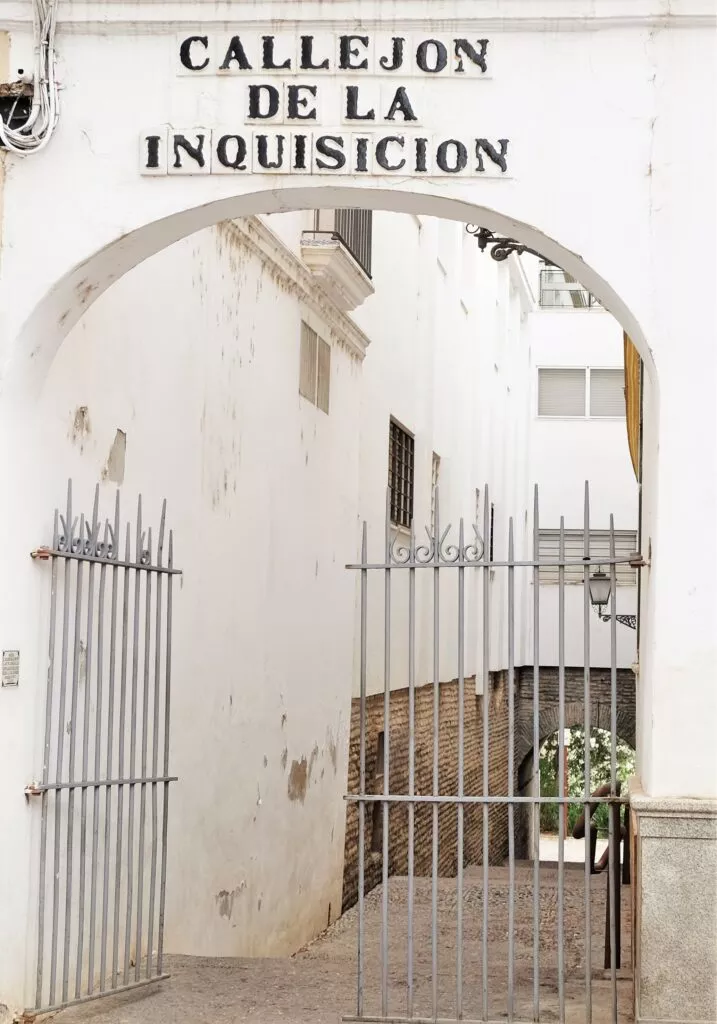
A word of history: this castle is itself built on the foundations of an ancient Almohad castle. Its 10th-century foundations and an Almohad cemetery were discovered by chance during development work for the 1992 Universal Exhibition.
Patios and corrals of Triana

The – patios – courtyards in the Triana neighbourhood are known to be among the most beautiful in Seville. They can be discovered by strolling through the streets of the district, mainly behind Calle Betis.

Altozano Square a lovely place to see in Triana in Seville
This square is located just after crossing the Isabel II Bridge. It is level with the market. In this square you will find two important statues, representative of the district. The first statue is called “Triana al arte flamenco“:

The second statue represents a bullfighter born in Triana. It is Juan Belmonte. The particularity of the sculpture is that there is an opening in the bullfighter’s torso. Standing behind the sculpture, you can see the bullring on the other side of the river.

The ceramics museum
Museo de la Cerámica de Triana: This museum displays a collection of Triana ceramics, a craft with a long tradition in this district.
Not far from here, you’ll find a number of ceramics shops, just behind the Triana market:

There is also a very nice bar-restaurant next door:

It’s a great place to stop for a coffee.

Casa Cuesta is the name of this bar-restaurant, and you can find its exact location here.
It’s just behind the Triana market, next to a small square, see below:
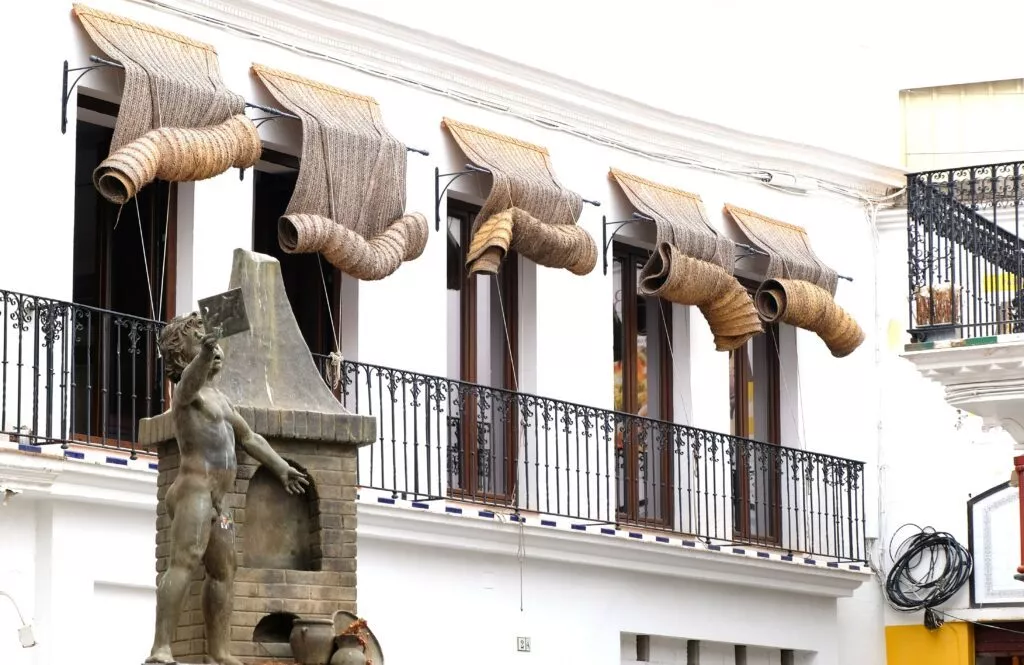
The church of Santa Ana
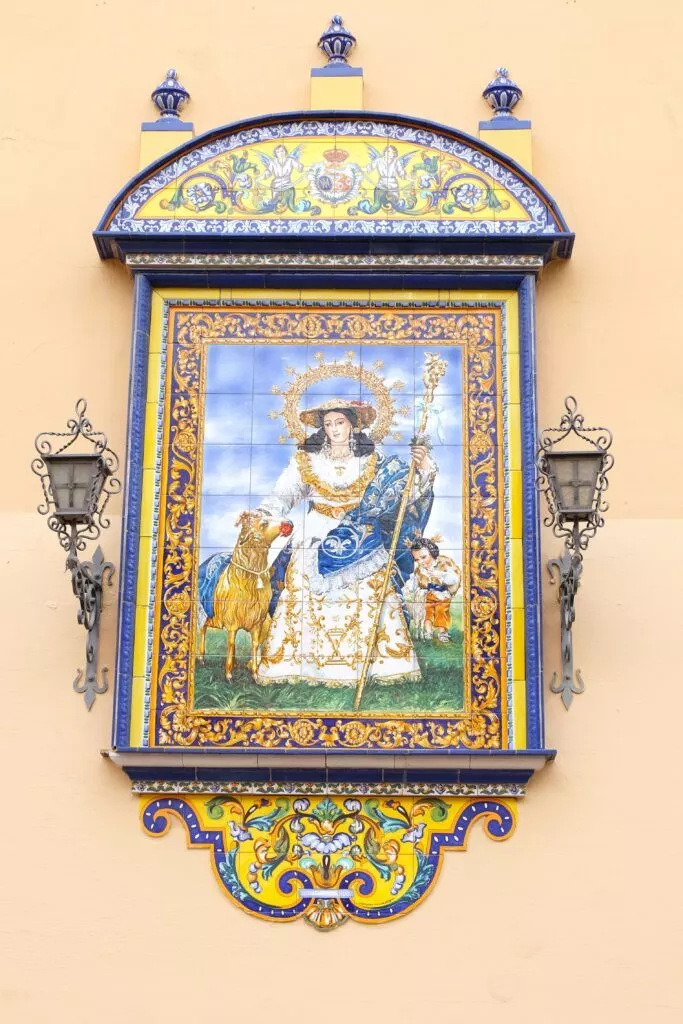
This church is on Calle Pelay Correa, one of the two streets running parallel to Calle Betis. Its construction was ordered in 1276, making it the oldest Catholic church in Seville! It is popularly known as the Cathedral of Santa Ana.

Above, the terrace of a bar right next to the Santa Ana church, which is very pleasant after your visit.
Calle San Jacinto in Triana

Calle San Jacinto is Triana’s main shopping street, running along the Isabel II bridge past the Altozano square.
The facades of the streets of Triana

A stroll through this district reveals the richness and beauty of its facades.

However, you can also appreciate the variety of colours on the façades.

Tapas and flamenco in Triana
The Triana district of Seville is a lively and colourful neighbourhood with a rich history and culture. It is famous for its flamenco. The most popular form of flamenco is soleá. Until the 1970s it was also known as the gypsy quarter.
Triana is the ideal place to enjoy an authentic flamenco show. Here is a small selection of the best flamenco tablaos in which to enjoy a show:
You can click on each link to find out more and/or book online:
- Casa de la Memoria de Triana, 6 Cuna Street
- Tablao Pura Esencia, 56 Betis Street,
- Here’s a third flamenco tablao in the Triana district.

This place is a pure delight, even if you have to enjoy the ceramics before entering. It’s called Teatro Flamenco Triana.
For some really good tapas in the district:
Here’s an original bar you really must try: Bar Juan Carlos. It serves around…100 cheeses…. numerous beers and some other very good specialities. It is located at Calle Febo, 6.
Here’s the exact location.
Note: for those interested – and curious – here’s a page with 8 great leisure activities to do in Seville.
English-speaking guide to Triana and the other neighbourhoods of Seville
For those who wish, there is a great English-speaking guide, Victor, who offers several options for private tours of Seville, in the different districts of Seville.

If you are in the western part of the Costa del Sol and would like an excursion to Seville, you can use the following link to book a day trip from Torremolinos, Mijas or Benalmadena.
Book accommodation in Triana Seville or centre
To book accommodation in Seville at the best price, it’s advisable to book well in advance.
Note: if you’re coming during the Seville Fair, it’s advisable to book even further in advance.
Book activities in Seville
Some useful links (car hire, ideas for visits)
Easy and economical bookings
What to see in Seville after the Triana neighbourhood
Seville, the Andalusian capital, is an incredibly rich city that deserves several days’ visit.
Here are some ideas for continuing your visit to Seville:
- 3 days to visit the centre of Seville and the Arenal district on foot:
- Cathedral
- Giralda
- Alcázar
- Macarena Basilica
- Plaza de España
- Maria Luisa Park
- las setas – Metropol Parasol –
- Church of the Divine Saviour
- the bullring
- Postigo Abd-el-Aziz
- Torre de Oro
- Head to the fabulous Santa Cruz district to discover some of the city’s wonders, including :
- the old judería
- Callejón del Agua
- Church of Santa María la Blanca
- Discover the unusual and secret Seville.
Continue your trip to Andalucia
Cadiz
Here’s a link to a visit that combines the sea and a beautiful city, for anyone staying in the area for a few days: what to see in Cadiz. This is your chance to discover Europe’s oldest city, steeped in history and lined with beautiful sandy beaches.

Cordoba

In this link, the monuments and districts to see in Cordoba Spain.
Granada

In this link, the monuments and districts to see in Granada Spain.
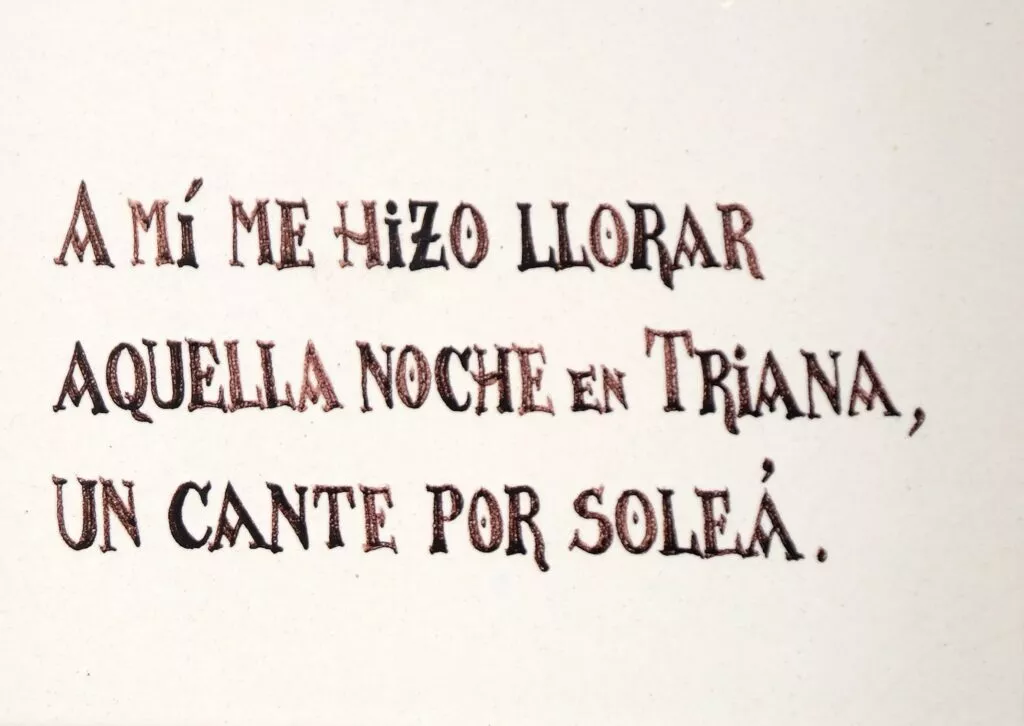
In the following link you will find other beautiful sites to discover, see the blog articles about Andalusia.
Here is the link to receive our newsletter from the blog andaluciamia.com

The latest articles on Andalucia
-
Interactive map of Andalucia with best places to see

An interactive map of Andalucia to discover the sites to see around your holiday destination or to prepare a tour or road-trip.
-
Top 15 Must-See Attractions in Ubeda, Spain

Here are the best places to visit and what to see in Ubeda. This Renaissance-style capital city of Andalusia is a marvel.
-
Visit Olula del Rio, the Mujer de Almanzora and the museum

Olula del Rio see its 3 wonders: an extraordinary marble sculpture, a surprising museum and an incredible photography centre.
-
Fiesta del Queso in Zuheros Cordoba

Discover the incredible Cheese Festival – Fiesta del Queso in Zuheros, one of the most beautiful white villages in Spain.








